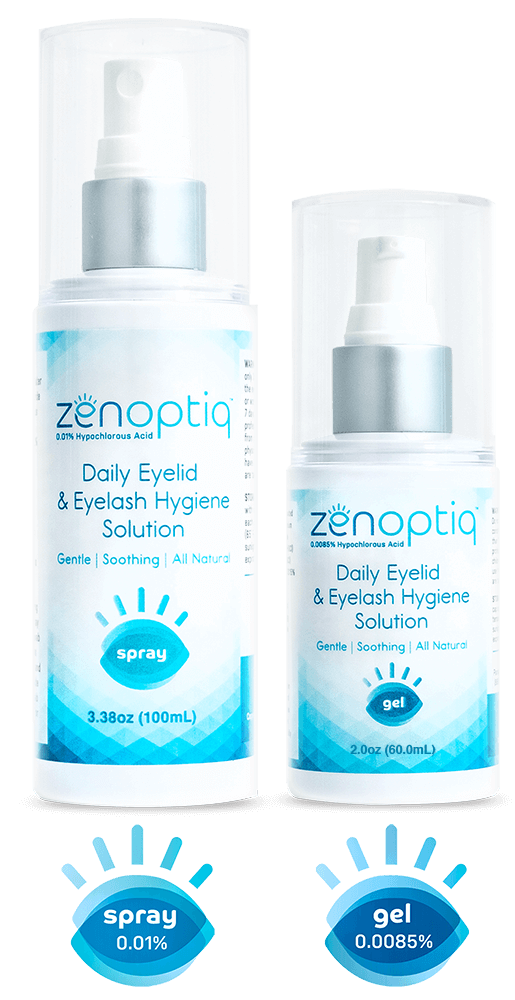
Zenoptiq™ is an all-natural, daily eyelid and eyelash cleanser that is proven to kill bacteria and soothe red, itchy, crusty eyelids.
Zenoptiq is proven to kill viruses, such as Adenoviruses (pink eye) and Herpes (ocular herpes), and 25 other tested microorganisms.
Zenoptiq is non-toxic, non-irritating and is steroid and antibiotic free which makes it safe to use with contact lenses and to remove makeup.
Zenoptiq comes in a shatterproof bottle and has an 18-month shelf life after opening.
Adenoviruses are known to cause a wide range of illnesses including Adenoviral conjunctivitis (Ad-CS), also known as pink eye. As one of the most common eye infections worldwide, pink eye has more than 20 million cases reported each year in the United States alone. [10]
Adenoviruses have no outer lipid bilayer and are highly resistant to disinfection.[5] The virus is transmitted directly through droplets or smears of infected bodily fluids, primarily tears or respiratory secretions, and by carriers such as towels, doorknobs, soap, counters, instruments, eye drops, and eyeglasses.[6] The period of contagion lasts about 3 weeks.[1] The incubation period for Ad-CS is about 10 days prior to the onset of symptoms. Symptoms typically persist for 7 to 28 days.
People with weakened immune systems, or existing respiratory or cardiac disease, are at higher risk of developing severe illness from an adenovirus infection. [7]
Caused by the herpes simplex virus, eye herpes is a common, recurrent viral infection affecting the eyes. This type of herpes can cause inflammation and scarring of the cornea that is sometimes referred to as a cold sore on the eye, and in extreme cases might lead to a corneal transplant.[3]
Eye herpes can range from a simple infection to a condition that can possibly cause blindness as there are several forms of eye herpes [3]:
The National Eye Institute says an estimated 400,000 Americans have experienced some form of ocular herpes, with close to 50,000 new and recurring cases occurring each year.[4]
Most people do not associate Escherichia Coli (E. coli) with the eye, however, E. coli can produce ocular infections including corneal ulcer and endophthalmitis, which can result in a devastating outcome. Early recognition and appropriate treatment is crucial. These infections most commonly occur in patients who are debilitated, immunocompromised, diabetic or in corneas with an underlying pathologic condition.[12]
Various strains of E. coli have been associated with eye infections such as, Corneal infection (due to E. coli), which produces indolent corneal ulcers. Also, endophthalmitis (due to E. coli), an inflammation of the interior of the eye usually related to surgery, has antimicrobial resistance that occurs through plasmid-mediated determinants. In endophthalmitis, the course of illness is very rapid, and complete destruction of intraocular tissues occurs. Men are four times more likely to have ocular trauma than women, which may lead to bacterial endophthalmitis.[12]
Millions of Americans suffer from chronic eye conditions—such as Dry Eye, MGD, and Blepharitis—which may be caused by a microbial invasion, or overpopulation of microorganisms, which can live on the eyelids and lashes.[11]
Using Zenoptiq, with its active ingredient Hypochlorous Acid (0.01% HOCl Spray, 0.0085% HOCl Gel), may reduce itch and inflammation commonly associated with MGD, Blepharitis, and Dry Eye.
Ocular Pruritus, severe itching of the skin around the eye, is a common symptom of several ocular related surface diseases (including MGD, Blepharitis, and Dry Eye) that can often significantly impact the quality of life, leading patients to their eye care professionals in search of relief.[9]
Staphylococcus aureus, a type of bacterial overgrowth on the skin, is commonly known to exacerbate Pruritus. Therefore, reducing the presence of S. aureus may reduce the debilitating symptoms of Pruritus.[9]
Zenoptiq kills 99.99% of Staphylococcus aureus within 30 seconds, via the time kill testing.*
HOCl is also especially effective in degrading biofilm (which is similar to a force field that helps protect bacteria) and neutralizing inflammatory mediators in the body to reduce bacterial growth on the skin. Imbalance of microorganisms within biofilm can lead to inflammation and potential for infection.[8]
Zenoptiq’s advanced stabilized formulation, in conjunction with its 18-month shelf life, provides an optimized potency of HOCl (0.01% HOCl Spray, 0.0085% HOCl Gel), making other commercially available products containing higher concentrations of HOCl nonessential.

[1] Meyer-Rusenberg B, Loderstadt U, Richard G, Kaulfers PM, et al. Epidemic keratoconjunctivitis: the current situation and recommendations for prevention and treatment. Dtsch Arztebl Int. 2011 Jul;108(27):475-80
[2] Suh, D. W., MD. (2018, November 08). Ophthalmologic Manifestations of Escherichia Coli Clinical Presentation. Retrieved from https://emedicine.medscape.com/article/1203472-clinical
[3] Eye Herpes (Ocular Herpes) Explained. (n.d.). Retrieved from https://www.allaboutvision.com/conditions/ocular-herpes.htm
[4] Facts About the Cornea and Corneal Disease. (2016, May 01). Retrieved from https://www.nei.nih.gov/health/cornealdisease/
[5] Sauerbrei A, Wutzler P. Virucidal efficacy of povidone-iodine-containing disinfectants. Lett Appl Microbiol. 2010 Aug;51(2):158-63
[6] Azar MJ, Dhaliwal DK, Bower KS, Kowalski RP, et al. Possible consequences of shaking hands with your patients with epidemic keratoconjunctivitis. Am J Ophthalmol. 1996 Jun;121(6):711-2
[7] Adenovirus | Symptoms | CDC. (2018, April 16). Retrieved from https://www.cdc.gov/adenovirus/about/symptoms.html
[8] Sakarya, S., MD, Gunay, N., MS, Karakulak, M., MS, Ozturk, B., MD, & Ertugrul, B., MD. (2014). Hypochlorous Acid: An Ideal Wound Care Agent with Powerful Microbicidal, Antibiofilm, and Wound Healing Potency. WOUNDS, 26(12), 342-350. pmid:25785777
[9] Pelgrift, R. Y., & Friedman, A. J. (2013, July 03). Topical Hypochlorous Acid (HOCl) as a Potential Treatment of Pruritus. doi:10.1007/s13671-013-0052-z. Retrieved from https://link.springer.com/article/10.1007/s13671-013-0052-z
[10] Garcia-Zalisnak, D., Rapuano, C., Sheppard, J. D., & Davis, A. R. (2018, September). Adenovirus Ocular Infections: Prevalence, Pathology, Pitfalls, and Practical Pointers. doi: Fwoun10.1097/ICL.0000000000000226. Retrieved from https://www.ncbi.nlm.nih.gov/pubmed/29664772
[11] Hellem, A. (2016, December). What You Should Know About Meibomian Gland Dysfunction (MGD). Retrieved from https://www.allaboutvision.com/conditions/meibomian-gland.htm
[12] Ophthalmologic Manifestations of Escherichia Coli. (2018, November 08). Retrieved from https://emedicine.medscape.com/article/1203472-overview